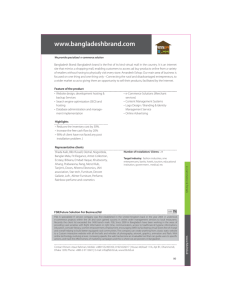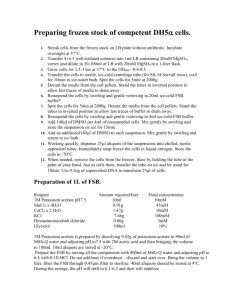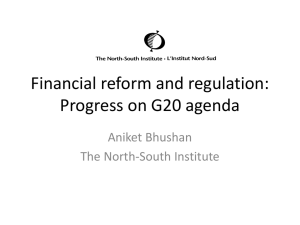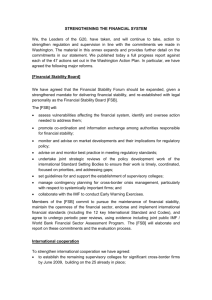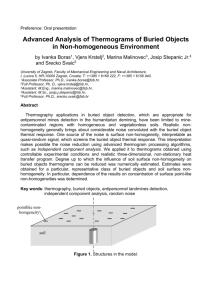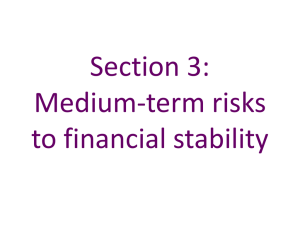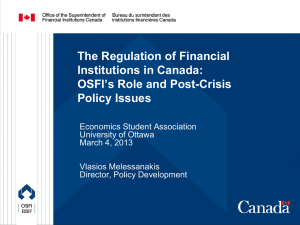Developments in the Financial System Architecture 4. International Regulatory
advertisement
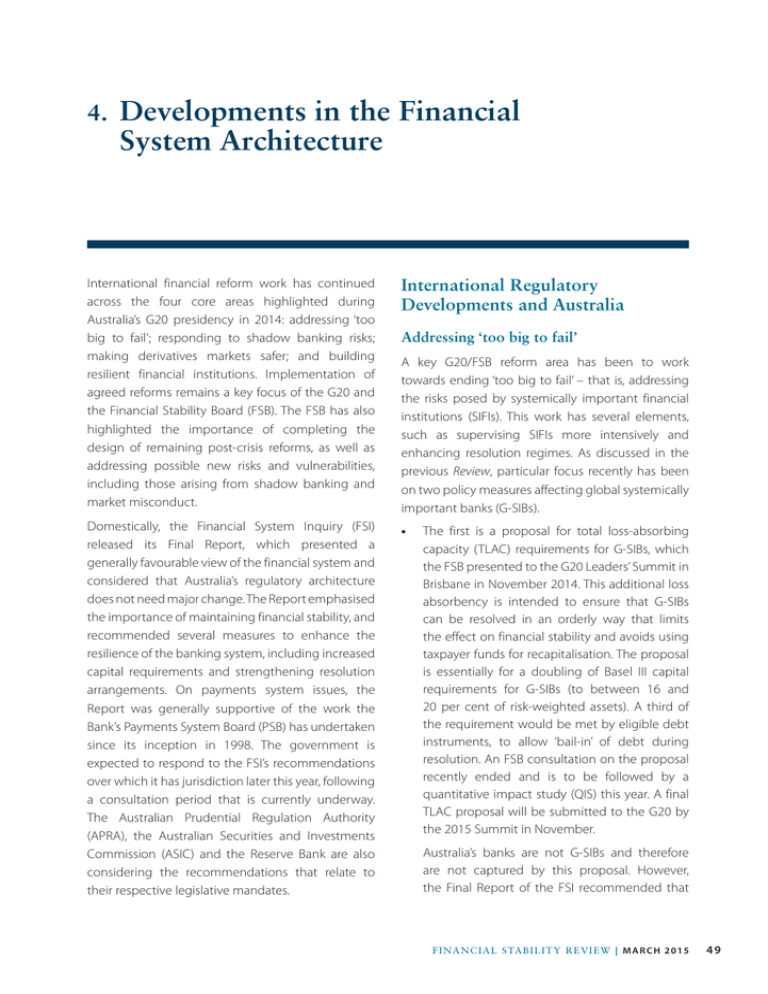
4.Developments in the Financial System Architecture International financial reform work has continued across the four core areas highlighted during Australia’s G20 presidency in 2014: addressing ‘too big to fail’; responding to shadow banking risks; making derivatives markets safer; and building resilient financial institutions. Implementation of agreed reforms remains a key focus of the G20 and the Financial Stability Board (FSB). The FSB has also highlighted the importance of completing the design of remaining post-crisis reforms, as well as addressing possible new risks and vulnerabilities, including those arising from shadow banking and market misconduct. International Regulatory Developments and Australia Domestically, the Financial System Inquiry (FSI) released its Final Report, which presented a generally favourable view of the financial system and considered that Australia’s regulatory architecture does not need major change. The Report emphasised the importance of maintaining financial stability, and recommended several measures to enhance the resilience of the banking system, including increased capital requirements and strengthening resolution arrangements. On payments system issues, the Report was generally supportive of the work the Bank’s Payments System Board (PSB) has undertaken since its inception in 1998. The government is expected to respond to the FSI’s recommendations over which it has jurisdiction later this year, following a consultation period that is currently underway. The Australian Prudential Regulation Authority (APRA), the Australian Securities and Investments Commission (ASIC) and the Reserve Bank are also considering the recommendations that relate to their respective legislative mandates. •• The first is a proposal for total loss-absorbing capacity (TLAC) requirements for G-SIBs, which the FSB presented to the G20 Leaders’ Summit in Brisbane in November 2014. This additional loss absorbency is intended to ensure that G-SIBs can be resolved in an orderly way that limits the effect on financial stability and avoids using taxpayer funds for recapitalisation. The proposal is essentially for a doubling of Basel III capital requirements for G-SIBs (to between 16 and 20 per cent of risk-weighted assets). A third of the requirement would be met by eligible debt instruments, to allow ‘bail-in’ of debt during resolution. An FSB consultation on the proposal recently ended and is to be followed by a quantitative impact study (QIS) this year. A final TLAC proposal will be submitted to the G20 by the 2015 Summit in November. Australia’s banks are not G-SIBs and therefore are not captured by this proposal. However, the Final Report of the FSI recommended that Addressing ‘too big to fail’ A key G20/FSB reform area has been to work towards ending ‘too big to fail’ – that is, addressing the risks posed by systemically important financial institutions (SIFIs). This work has several elements, such as supervising SIFIs more intensively and enhancing resolution regimes. As discussed in the previous Review, particular focus recently has been on two policy measures affecting global systemically important banks (G-SIBs). F IN AN C IAL STAB IL ITY R E VIE W | M A R C H 2 0 1 5 49 APRA should develop a framework for minimum loss-absorbing capacity for Australian authorised deposit-taking institutions (ADIs) in line with emerging international practice. Through the FSB and the G20, the Bank and other Council of Financial Regulators (CFR) agencies have been closely engaged in the development of the TLAC proposal, partly because international appetite could emerge to apply the framework beyond G-SIBs. •• The second is an industry agreement to prevent cross-border derivative contracts from being terminated disruptively once a G-SIB enters resolution. The International Swaps and Derivatives Association, in consultation with regulators and the FSB, has developed a protocol for over-the-counter (OTC) derivatives contracts that are not centrally cleared. If adhered to by both counterparties, this protocol will enable temporary stays of early termination rights to be enforced across borders. An initial set of 18 G-SIBs (reportedly representing 90 per cent of derivatives trading activity) have to date adhered to the protocol. The two specific proposals above are part of broader ongoing international efforts to enhance resolution frameworks for global SIFIs (G-SIFIs) and financial institutions more generally. Central to these efforts is the Key Attributes of Effective Resolution Regimes for Financial Institutions (Key Attributes), released by the FSB in 2011 and which the G20 has committed to implementing for all parts of the financial sector that could be systemic in the event of failure. In November, the FSB reported to the G20 on progress in reforming resolution regimes, resolution planning for G-SIFIs, and implementing the Key Attributes. The report concluded that while many FSB jurisdictions have adopted the powers and tools needed to resolve failing banks, few jurisdictions have resolution regimes in place that are fully compliant with the Key Attributes, and that also provide adequate powers for resolving failures in the non-bank financial sector. The FSB is currently conducting a peer review on resolution regimes for 50 R ES ERV E BA NK OF AUS T RA L I A banks, which should provide a further update on current and planned reforms in this area. In October 2014, the FSB incorporated new annexes into the Key Attributes providing guidance covering: resolution of financial market infrastructures (FMIs) and insurers; the protection of client assets in resolution; and arrangements for information sharing that support the effective resolution of cross-border financial institutions. The resilience and resolution of FMIs, and in particular central counterparties (CCPs), is gaining increased attention as CCPs play a more central role in the financial system. Particular areas of focus include the level of stress that CCPs should be designed to withstand, as well as recovery planning and resolution arrangements for CCPs. In this regard, the Committee on Payments and Market Infrastructures (CPMI) and the International Organization of Securities Commissions (IOSCO) also released in October a report on FMI recovery. At their February meeting, G20 Ministers and Governors asked the FSB, working with the CPMI, IOSCO and the Basel Committee on Banking Supervision (BCBS), to report in April on a work plan on CCP resilience, recovery and resolution, with particular attention to potential financial stability risks arising where CCPs are systemic in multiple jurisdictions. Australian authorities have also been working on FMI resolution in recent years. In February, the government, acting on the advice of CFR agencies, launched a consultation process on proposals for a special resolution regime for FMIs. The regime would cover: domestic clearing and settlement facilities, with the Bank as the resolution authority; and domestic trade repositories that are identified as systemically important, with ASIC as the resolution authority. The scope and structure of the proposed regime and the powers envisaged are consistent with the Key Attributes. The consultation closes on 27 March. The consultation paper on FMI resolution is part of broader ongoing work by CFR agencies to strengthen domestic resolution and crisis management arrangements. This includes a recent review by agencies of crisis management procedures, and ongoing engagement with New Zealand authorities in this area. Also in October, the FSB issued for consultation draft guidance on: •• •• crisis management group (CMG) cooperation and information sharing with non-CMG host authorities in jurisdictions where a G-SIFI has a systemic presence. The Key Attributes require home and key host authorities of G-SIFIs to maintain CMGs. However, this could end up excluding some jurisdictions where operations of the firm are locally systemic but not material to the resolution of the overall group. Because those jurisdictions may be directly affected if the firm fails, the Key Attributes therefore require cooperation and information sharing between CMGs and non-CMG host jurisdictions. the identification of the critical functions and critical shared services for systemically important insurers. The guidance aims to assist national authorities in implementing the recovery and resolution planning requirements set out in the Key Attributes and in the policy measures of the International Association of Insurance Supervisors (IAIS) for global systemically important insurers (G-SIIs). In a related step, the IAIS finalised in October its ‘basic capital requirement’ for G-SIIs and in December it also began a consultation on a risk-based global insurance capital standard that would apply to all globally active insurers. International work continues in the area of identifying G-SIFIs, which is the first step in imposing additional requirements on them. •• The FSB released in November updated lists of G-SIBs and G-SIIs. In updating the latter, the FSB noted that by November 2015, the IAIS will further develop the G-SII assessment methodology to ensure that it appropriately addresses all types of insurance and reinsurance, and other financial activities of global insurers. The revised G-SII assessment methodology will be applied from 2016. •• In March 2015, the FSB and IOSCO released a second consultation paper on identification methodologies for non-bank non-insurer (NBNI) G-SIFIs – essentially large cross-border financial institutions operating in the shadow banking sector. Following feedback on earlier released proposals, the new paper includes near-final methodologies for finance companies and market intermediaries (broker-dealers), a revised methodology for investment funds (including hedge funds), and a new proposed methodology for asset managers. The methodologies are expected to be finalised by the end of 2015, after which the FSB and IOSCO will begin work to develop any policy measures needed to address the risks posed by NBNI G-SIFIs. Shadow banking Work is continuing to strengthen the oversight and regulation of shadow banking, in line with an updated 2015 ‘roadmap’ reported to the G20 Leaders in November. Shadow banking, which the FSB defines as credit intermediation outside the regular banking system, covers entities and activities such as money market funds (MMFs), asset managers and securities financing transactions (SFTs). The FSB has been coordinating international reform work over recent years to address the problems revealed by the global financial crisis, with the aim of transforming shadow banking into resilient ‘market-based financing’ for the economy. With many of the post-crisis shadow banking reforms released in 2012 and 2013, the focus more recently has been on implementation. Peer reviews in this area by the FSB and IOSCO are planned for, or ongoing in, 2015. The FSB is soon to commence a peer review on the implementation of its 2013 framework for shadow banking entities other than MMFs, such as finance companies. As part of that peer review, the FSB will initiate a comprehensive information sharing process, to ensure existing shadow banking risks in jurisdictions are adequately addressed, and to enhance understanding of evolving potential risks such as new innovative F IN AN C IAL STAB IL ITY R E VIE W | M A R C H 2 0 1 5 51 forms of shadow banking. IOSCO will publish in the second quarter of 2015 its peer review reports on the implementation by jurisdictions of its recommendations on MMFs and securitisation. In banking regulation developments related to securitisation: •• The BCBS released its revised securitisation capital framework in December. This framework aims to strengthen capital standards for securitisation exposures held in the banking book and reduce reliance on external ratings. •• Also in December, the BCBS and IOSCO published proposed criteria for identifying ‘simple, transparent and comparable’ securitisation structures; the BCBS will consider this year how the finalised criteria could be incorporated into the capital framework. •• Domestically, APRA is continuing with proposed changes to simplify the prudential framework for securitisation and in November responded to certain issues raised during industry consultation. APRA expects a revised prudential standard will be issued for consultation later in the year. The FSB has continued its work in the area of SFT regulation and released in October a regulatory framework for haircuts on non-centrally cleared SFTs.1 This framework takes into account feedback received on the FSB’s 2013 policy framework for securities lending and repos, as well as the results of a QIS. It aims to limit the build-up of excessive leverage outside the banking system and to help reduce the procyclicality of that leverage. It consists of (i) qualitative standards for methodologies used by market participants that provide securities financing to calculate haircuts on the collateral received; and (ii) numerical haircut floors that will apply to non-centrally cleared transactions providing financing against collateral other than 1 A haircut is a percentage discount deducted from the market value of the security that is being offered as collateral in a repo or similar SFT. In adjusting the market value of collateral, a haircut reflects the risk that the cash realised by the liquidation of collateral securities may turn out to be less than the quoted market value of those securities (due, for example, to issuer credit and market liquidity risks on the securities). 52 R ES ERV E BA NK OF AUS T RA L I A government securities to entities other than banks and broker-dealers. In finalising the framework, the FSB has raised the levels of numerical haircut floors based on the QIS results, existing market and central bank haircuts, and data on historical price volatility of different asset classes. The FSB also consulted on a proposal to apply the numerical haircut floors to non-bank-to-non-bank transactions so as to ensure shadow banking activities are fully covered, to reduce the risk of regulatory arbitrage and to maintain a level playing field. The FSB will complete its work on this last proposal by the second quarter of 2015. FSB jurisdictions are to implement the framework for SFTs, including the numerical haircut floors, by the end of 2017. In a related development, the FSB published in November 2014 a consultative report on Standards and Processes for Global Securities Financing Data Collection and Aggregation, which is based on the FSB’s 2013 policy framework. The FSB recommended that national authorities collect appropriate data on securities financing markets to detect financial stability risks and develop policy responses, and to provide the total data for these markets to the FSB for aggregation in order to assess global trends in financial stability. The consultation closed in February. With many international shadow banking reforms now finalised, CFR agencies are further considering their potential application to Australia. The main areas of current focus are the FSB’s 2013 framework for shadow banking entities other than MMFs, and proposals for regulations on SFTs such as minimum haircuts, and data collection and aggregation standards. This work will help to ensure that Australian regulatory arrangements are proportionate to the risks, and also to assure the international regulatory community that risks are being addressed appropriately. CFR agencies have already acted on one of the FSB’s SFT recommendations, namely consideration of the potential role for a CCP in repo markets, to help ensure that these markets function continuously expected that authorities will implement the standards ‘as soon as practicable’, potentially alongside the phase-in of margin requirements for non-centrally cleared derivatives. The margin requirements, which were developed by the BCBS and IOSCO, are scheduled to be phased in from 1 September 2016. and effectively, even in stressed circumstances. Consistent with developments in other core markets, such as that for OTC interest rate derivatives, the FSB recommended that authorities evaluate the costs and benefits of introducing CCPs in their interdealer repo markets, with a view to mitigating systemic risks. No CCP currently clears transactions in the Australian repo market. Therefore, the Bank issued a consultation paper in March 2015 inviting stakeholder views on how the availability of a repo CCP might affect the functioning of the Australian repo market and the management of risk. •• OTC derivatives markets International progress in implementing agreed OTC derivatives market reforms continues to be slow and uneven, reflecting difficulties in overcoming issues arising from the cross-border reach of regulation. A current focus is promoting deference to other jurisdictions’ rules. To inform the policy debate in this area, the FSB issued a report in September summarising the outcome of a survey of regulatory authorities’ ability to defer to one another in the cross-border regulation of OTC derivatives markets and FMIs. Australia’s regime compared favourably with others in both the scope for deference and existing arrangements with other jurisdictions. The OTC Derivatives Regulators Group has undertaken work to address cross-border implementation issues that were identified in its report to the G20 Summit in November, and the FSB will continue to promote the appropriate use of deference in the cross-border application of derivatives regulations. Work is continuing by the FSB and standard-setting bodies in other areas of derivatives markets. •• Part of the regime for products that cannot be cleared by a CCP is a set of rules for managing the risks in other ways. In January, IOSCO published its final ‘Risk Mitigation Standards for Non-centrally Cleared OTC Derivatives’. The standards cover documentation, trade confirmation, valuation, portfolio reconciliation, compression and dispute resolution. It is While progress has been made to reduce the opacity of OTC derivative markets, there are still significant legal and other barriers to the reporting, sharing and aggregation of key information about trades. The FSB and other bodies are working on removing these obstacles. By the G20 Summit in November 2015: –– The FSB will identify the legal barriers in member jurisdictions to reporting counterparty information to trade repositories and set a deadline for jurisdictions to address these barriers. –– The CPMI and IOSCO will propose guidance on the design of a global Unique Transaction Identifier and Unique Product Identifier to aid consistent trade reporting. –– IOSCO will finalise its cross-border regulatory toolkit that will be applicable not only to OTC derivatives but also to regulation of other markets. Since September, Australian authorities have made further progress in establishing cooperative arrangements with overseas authorities to support the roll-out of regulatory reforms in OTC derivatives markets and regulation of cross-border FMIs. In particular: •• The European Union (EU) adopted equivalence decisions for the regulatory regimes for CCPs in Australia, Hong Kong, Japan and Singapore in October 2014. Further to this determination, the Bank and ASIC concluded a Memorandum of Understanding (MoU) with the European Securities and Markets Authority (ESMA) to govern cooperation and information sharing in the regulation of CCPs. ESMA is currently F IN AN C IAL STAB IL ITY R E VIE W | M A R C H 2 0 1 5 53 Basel III regulations on liquidity, leverage and systemically important banks. considering the Australian Securities Exchange’s (ASX’s) applications for CCP recognition in the EU. •• In December, the US Commodity Futures Trading Commission (CFTC) invited ASX Clear (Futures) and other non US-based CCPs to apply for permanent exemption from the requirement to register with the CFTC as a ‘derivatives clearing organisation’. To date, the CFTC has issued only time-limited relief from this registration requirement to non US-based CCPs. •• In February, the Bank and ESMA signed an MoU on access to trade repository data. This will allow European trade repositories to provide the Bank with data relevant to the Bank’s mandate that is reported under European rules. ASIC signed a similar MoU with ESMA in November. In parallel, further to the regulators’ recommendations in April 2014, work continues domestically to implement mandatory clearing obligations for internationally active dealers in Australian dollar-, US dollar-, euro-, British pound- and Japanese yen-denominated interest rate derivatives. Submissions to a July 2014 government proposals paper were generally supportive. The government is now expected to consult on the determination and regulations in coming months, with ASIC issuing a consultation paper on its Derivative Transactions Rules on clearing at around the same time. Building resilient financial institutions Banks globally and in Australia continue to move towards meeting the new Basel III capital and liquidity reforms. The BCBS regularly monitors the implementation of these reforms and assesses the consistency of the implemented reforms through its Regulatory Consistency Assessment Programme (RCAP). •• 54 In November, the BCBS released a report to the G20 Leaders detailing member jurisdictions’ progress in implementing the Basel III regulatory reforms. This report found that all member jurisdictions have implemented the Basel risk-based capital regulations and members have now turned their efforts to adopting the R ES ERV E BA NK OF AUS T RA L I A •• The latest results from the BCBS’ Basel III monitoring exercise were released in March 2015. As at 30 June 2014, all large internationally active banks met the 4.5 per cent common equity Tier 1 (CET1) minimum capital requirement. The amount of additional capital needed by these banks to meet their CET1 target ratios (including the capital conservation buffer and any G-SIB capital surcharges) had been further reduced, implying that their capital positions had strengthened. Over 80 per cent of participating banks met the 100 per cent Basel III Liquidity Coverage Ratio (LCR) required by 2019, with around 95 per cent meeting the 2015 phase-in requirement of 60 per cent. Banks that did not meet the 60 per cent requirement had an aggregate LCR shortfall of €155 billion. The BCBS published in December 2014 RCAP assessments of the Basel III frameworks in the EU and United States, and in March, those for Hong Kong and Mexico. •• The EU was deemed materially non-compliant with the Basel III capital framework, reflecting material non-compliance with the internal ratings-based (IRB) approach for credit risk and non-compliance with the counterparty credit risk framework. In the EU, IRB banks are able to use standardised risk weights for certain exposures. In particular, central government exposures are eligible for a zero risk weight under the standardised approach; however, these exposures would likely be subject to a small positive risk weight under the IRB approach. In terms of the EU’s counterparty credit risk framework, derivatives exposures to certain counterparties are exempt from credit valuation adjustment (CVA) capital charges. While the report suggests legislative changes are necessary to address these two issues, the EU authorities noted that they have already taken measures to limit the use of standardised risk weights by IRB banks over time and also that •• •• the BCBS is considering making major changes to the CVA risk capital requirements. internal model-based approaches, and has issued consultation papers in recent months on: The United States was deemed largely compliant with the Basel III capital framework, despite material non-compliance with both the securitisation framework and standardised measurement method for market risk. In response, the US authorities indicated that they will consider amending their securitisation rules in 2015. The authorities will also consider making legislative changes to address their material non-compliance with the standardised measurement method for market risk once the BCBS completes its fundamental review of the trading book. •• proposed revisions to the standardised approach for credit risk that aim to strengthen the capital framework by reducing the reliance on credit rating agency ratings, increasing the risk sensitivity of capital requirements (including on residential mortgages), and allowing for greater comparability with the IRB approach •• outstanding issues for its fundamental review of the trading book capital standards, to improve trading book capital requirements and to promote consistent implementation of the rules so that they produce comparable levels of capital across jurisdictions For Hong Kong and Mexico, the implementation of the risk-based capital standards and the LCR was found, overall, to be compliant with the Basel framework. In Hong Kong, 12 out of 13 components were assessed as compliant, while one component, Pillar 3, was determined to be largely compliant with the Basel standards. In Mexico, 12 out of 14 components were assessed as compliant, while the countercyclical buffer and Pillar 3 were considered largely compliant. •• proposed revisions to the standardised approach for measuring operational risk capital •• the design of the revised capital floor framework, which aims to: ensure a prudent level of capital across the banking sector; reduce model risk and measurement error stemming from internal model-based approaches; address issues relating to banks’ incentives when modelling risk weights; and improve the comparability of risk-weighted capital ratios. While much of the policy development work on the new capital and liquidity reforms has been completed, the BCBS has continued work on outstanding elements of the Basel III framework. The Net Stable Funding Ratio, which aims to make banks’ funding structures more resilient, was finalised in October. In November, the BCBS outlined its plan to G20 Leaders for addressing excessive variability in the measurement of risk-weighted assets for capital adequacy purposes, to improve the consistency and comparability of banks’ capital ratios. Among other policy measures, this plan includes a review of the standardised approaches for calculating regulatory capital and a revised capital floor based on these new standardised approaches. Consistent with the plan, the BCBS finalised in January 2015 improved disclosure requirements for banks’ The BCBS has also enhanced elements of its wider set of guidance and principles for banking regulation. In October 2014, it issued for consultation revised corporate governance principles for banks and in February 2015 the BCBS outlined supervisory expectations regarding sound credit risk practices associated with implementing and applying an ‘expected credit loss’ accounting framework. Market conduct and risk management Recently, there has been increased focus by the G20, the FSB and other bodies on market misconduct by banks and other financial institutions, such as in the area of financial benchmarks. The concern is that the scale of recent misconduct in some financial institutions could create systemic risks by undermining trust in financial institutions and markets. As part of further work in this area, the F IN AN C IAL STAB IL ITY R E VIE W | M A R C H 2 0 1 5 55 requirements (to make them ‘unquestionably strong’), increase mortgage risk weights for the (currently five) banks using the IRB approach for capital, and develop a framework for minimum loss-absorbing capacity. According to the Report, the costs of higher capital on lending rates and GDP growth would be small. The BCBS’ revisions to elements of the capital framework, discussed above and which are due to be finalised by the end of this year, are likely to be relevant for implementation of these recommendations. FSB will consider whether enforcement can be made more effective, and thereby credibly deter misconduct, by increasing cross-border cooperation between conduct supervisors and enhancing consistency in market regulation. Other reforms the FSB will consider in this area include (i) assessing reforms to risk governance, compensation structures and benchmarks and, where appropriate, proposing additional measures in these areas; and (ii) considering ways to improve market structure, standards of practice and incentives for good conduct in financial markets more broadly. In February, the Joint Forum (comprising the BCBS, IAIS and IOSCO) reported on changes in firms’ credit risk management practices since 2006. The Joint Forum’s proposed recommendations for supervisors emphasised: caution of an over-reliance on internal models; awareness of an increase in ‘search for yield’ behaviour; recognition of the increasing need for high-quality liquid collateral to meet margin requirements for OTC derivatives transactions; and consideration of whether firms are accurately capturing CCP exposures. In a related area, the Inquiry considers that ex-post funding of the Financial Claims Scheme should be maintained, as its other recommendations, if implemented, should reduce the need to activate the Scheme. In 2013, the CFR advised the previous government to implement ex-ante funding. •• Regarding the broader regulatory framework, the Report concludes that Australia’s ‘regulatory architecture does not need major change’. In particular, no fundamental changes are recommended for macroprudential arrangements or the membership/structure of the CFR. The Report does, however, recommend several ‘minor refinements’ around regulator accountability, including the creation of a Financial Regulator Assessment Board to conduct annual independent reviews of APRA, ASIC and the payments regulation function of the Bank. •• In the area of payments, the Report acknowledges the critical role payment systems play in the broader financial system, and emphasises the need for efficiency, transparency and innovation in this area. On retail payment systems, the Report addresses issues related to card interchange fees and surcharging – many of which the Bank raised in its submissions to the Inquiry. The Report recommends that the PSB consider a range of possible changes to card payments regulation; the Bank initiated a consultation on these and related issues in March. The FSI also recommends simplifying the regulatory framework for payment systems, Other Domestic Regulatory Developments Financial System Inquiry The Financial System Inquiry Final Report was released in early December. The Inquiry found that Australia’s financial system is performing well and recommended incremental rather than ‘root and branch’ changes to domestic regulatory arrangements, a conclusion consistent with the Bank’s submissions to the Inquiry. In the payments system area, the Report was generally supportive of the work of the PSB, though it made several recommendations that are being considered by the PSB. Some of the main recommendations relating to resilience, regulatory architecture and payments are outlined below. •• 56 To improve banking sector resilience, the Report recommends that APRA raise ADIs’ capital R ES ERV E BA NK OF AUS T RA L I A particularly for Purchased Payment Facilities (PPFs). This would include APRA developing a new two-tiered prudential regime for PPFs, and the government and ASIC narrowing the licensing regime for non-cash payment facility providers; these actions are to be undertaken in consultation with other regulators, including the Bank. The Report also calls for existing processes for strengthening crisis management powers to be completed; these had been put on hold pending the outcome of the Inquiry. They include legislative amendments recommended by the CFR, such as introducing a special resolution regime for FMIs. As noted earlier, the government recently released a consultation paper on this recommendation. The CFR also expects to release soon a related consultation paper, which seeks to clarify the regulators’ approach to assessing whether an overseas clearing and settlement facility falls within the scope of the Australian licensing regime. The government is currently conducting a public consultation process on the FSI recommendations. Submissions close on 31 March, with the government’s final response expected later in the year. The Bank will continue to be actively engaged with the FSI process as required. As such, these proposals, combined with the FSI’s recommendations for APRA to (i) impose increased capital requirements for ADIs, and (ii) develop a framework for minimum loss-absorbing capacity, point to possible increased capital requirements for ADIs in the period ahead. The size of any increase in capital requirements will depend on the BCBS’ finalisation of its proposals, and the response by the government and APRA to the FSI’s recommendations. Meanwhile, following consultation, APRA finalised several elements of its prudential framework for the entities it supervises. •• In October APRA issued a prudential practice guide on group insurance arrangements. The guide addresses poor risk management practices identified in the group insurance market. APRA also released the results of its peer comparison of insurers’ Internal Capital Adequacy Assessment Process reports. APRA determined that the reports were adequate, but noted areas where they did not meet APRA’s expectations. •• In November APRA released a final prudential practice guide on residential mortgage lending, which provides guidance on its view of sound lending practices. In conjunction with the release, ASIC updated its responsible lending guidance, clarifying that lenders must inquire about consumers’ actual incomes and expenses, and not rely on benchmark living expenses applying to typical or low-income households. •• A prudential standard and practice guide on risk management for the banking and insurance industries were released in December. The guide encourages institutions to implement effective risk governance models in line with APRA’s heightened expectations of risk management practices. Prudential framework Several recent international and domestic developments are likely to place upward pressure on capital requirements for Australian ADIs. Some recent BCBS proposals, including several noted above, may result in higher capital requirements for ADIs. For example: •• the revised capital floor may be binding for ADIs using internal models-based approaches •• the proposed changes for calculating mortgage risk weights could increase risk weights for ADIs using the standardised approach for credit risk, while the revised approach for operational risk is also likely to increase capital requirements in general for ADIs. Competition in cash equities In February, the government announced a review of competition in the clearing of Australian cash equities, to be conducted by the CFR, working with the Australian Competition and Consumer F IN AN C IAL STAB IL ITY R E VIE W | M A R C H 2 0 1 5 57 Commission. The CFR subsequently issued a consultation paper seeking stakeholder views on the potential implications of competition or alternative policy approaches for the Australian cash equity market. The review comes after a two-year moratorium on competition in this area, which followed a 2012 review into the matter by the same agencies. While the moratorium was in place, the ASX was encouraged to work with industry to develop a code of practice to govern its clearing and settlement services for cash equities; the code of practice was introduced in August 2013. It is anticipated that the findings of the CFR’s review will be presented to the government in mid 2015. R 58 R ES ERV E BA NK OF AUS T RA L I A

